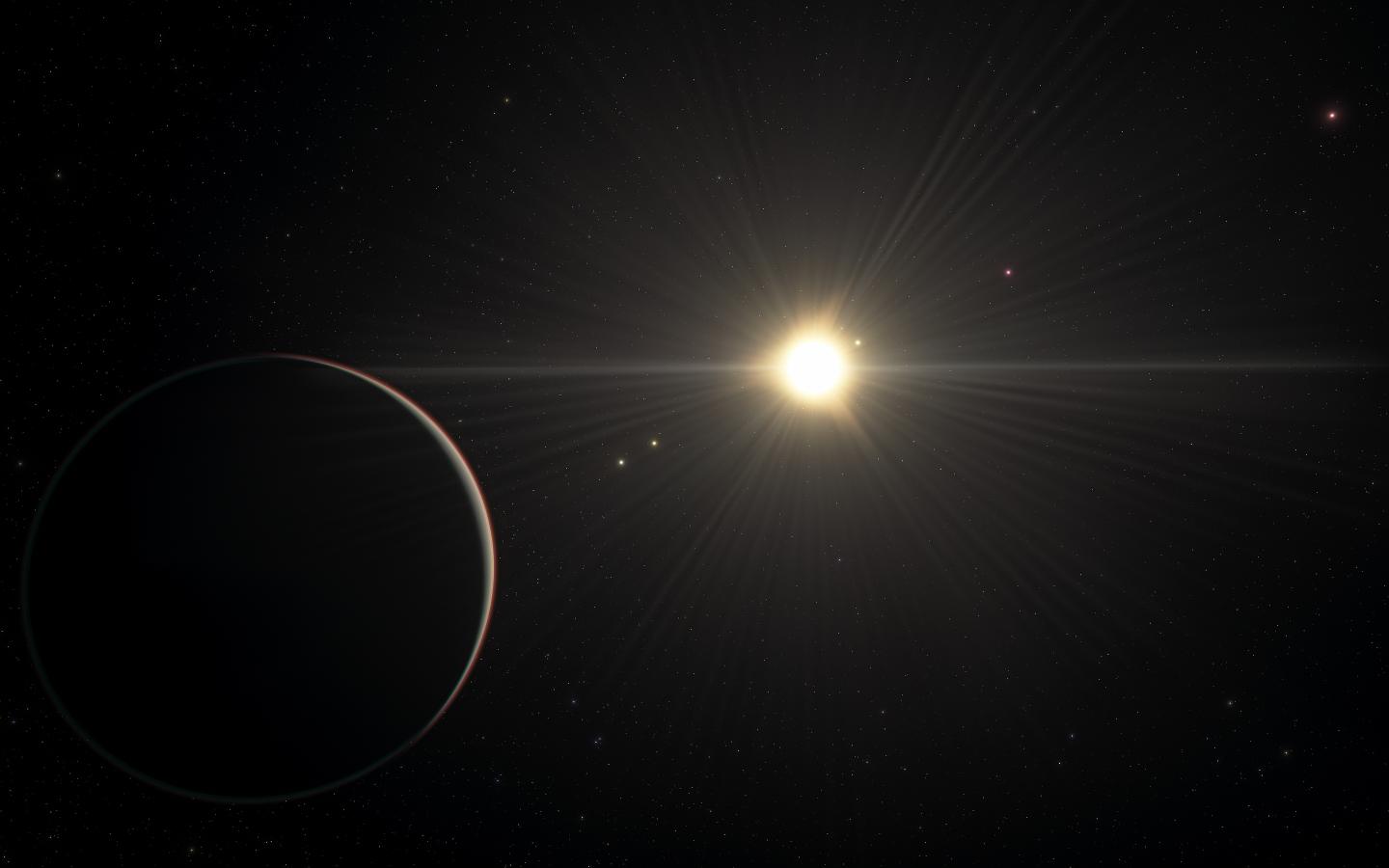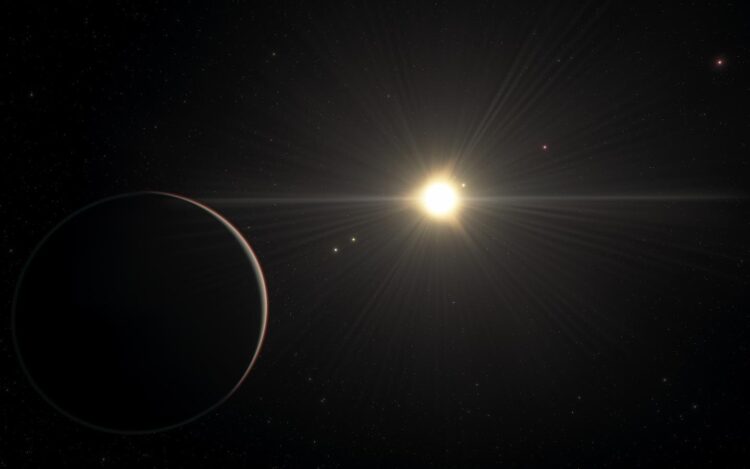
Credit: © ESO
Musical notes that sound pleasant together can form a harmony. These notes are usually in a special relationship with each other: when expressed as frequencies, their ratios result in simple fractions, such as four-thirds or three-halves. Similarly, a planetary system can also form a kind of harmony when planets, whose orbital period ratios form simple fractions, regularly attract each other with their gravity. When one planet takes three days to orbit its star and its neighbor takes two days, for example. Using the CHEOPS space telescope, scientists, led by astrophysicist Adrien Leleu of the Center for Space and Habitability of the University of Bern, the University of Geneva and the National Center of Competence in Research PlanetS, found such relationships between five of six planets orbiting the star TOI-178, located over 200 light years away from Earth. The results were published in the journal Astronomy and Astrophysics.
A missing piece in an unexpected puzzle
“This result surprised us, as previous observations with the Transiting Exoplanet Survey Satellite (TESS) of NASA pointed toward a three planets system, with two planets orbiting very close together. We therefore observed the system with additional instruments, such as the ground based ESPRESSO spectrograph at the European Southern Observatory (ESO)’s Paranal Observatory in Chile, but the results were inconclusive.”, Leleu remembers. When he and his colleagues first proposed to investigate the system more closely, they were therefore not sure what they would find. The high precision and target-pointing agility of CHEOPS was required to bring clarity, but that turned out to be more difficult than expected. “After analyzing the data from eleven days of observing the system with CHEOPS, it seemed that there were more planets than we had initially thought”, Leleu says. The team identified a possible solution with five planets and decided to invest another day of precious observation time on the system to confirm. They found that there were indeed five planets present with orbital periods of around 2, 3, 6, 10 and 20 days respectively.
While a system with five planets would have been quite a remarkable finding in itself, Leleu and his colleagues noticed that there might be more to the story: the system appeared to be in harmony. “Our theory implied that there could be an additional planet in this harmony; however its orbital period needed to be very nearly 15 days.”, Leleu explains. To check if their theory was in fact true, the team scheduled yet another observation with CHEOPS, at the exact time that this missing planet would pass by – if it existed. But then, an accident threatened to cancel their plans.
Prediction confirmed despite near-collision
“Just before the time of the observation, a piece of space debris threatened to collide with the CHEOPS satellite”, as co-author and Professor of Astrophysics at the University of Bern, Yann Alibert, recalls. Therefore, the control center of the European Space Agency (ESA) initiated an evasive maneuver of the satellite and all observations were interrupted. “But to our great relief, this manoeuver was done very efficiently and the satellite could resume observations just in time to capture the mysterious planet passing by”, as Nathan Hara, co-author and astrophysicist from the University of Geneva reports. “A few days later, the data clearly indicated the presence of the additional planet and thus confirmed that there were indeed six planets in the TOI-178 system”, Hara explains.
A system that challenges current understanding
Thanks to the precision of CHEOPS’ measurements as well as previous data from the TESS mission, the ESO’s spectrograph ESPRESSO, and others, the scientists could not only measure the periods and sizes of the planets of 1.1 to 3 times the radius of the Earth, but also estimate their densities. With that came another surprise: compared to the harmonic, orderly way the planets orbit around their star, their densities appear to be a wild mixture.
“It is the first time we observe something like this”, as ESA Project Scientist Kate Isaak points out and adds that “in the few systems we know with such a harmony, the density of planets steadily decreases as we move away from the star. In the TOI-178 system, a dense, terrestrial planet like Earth appears to be right next to a very fluffy planet with half the density of Neptune followed by one very similar to Neptune”.
As Adrien Leleu concludes, “the system therefore turned out to be one that challenges our understanding of the formation and evolution of planetary systems”.
CHEOPS – in search of potential habitable planets
The CHEOPS mission (CHaracterising ExOPlanet Satellite) is the first of ESA’s newly created “S-class missions” – small-class missions with an ESA budget much smaller than that of large- and medium-size missions, and a shorter timespan from project inception to launch.
CHEOPS is dedicated to characterizing the transits of exoplanets. It measures the changes in the brightness of a star when a planet passes in front of that star. This measured value allows the size of the planet to be derived, and for its density to be determined on the basis of existing data. This provides important information on these planets – for example, whether they are predominantly rocky, are composed of gases, or if they have deep oceans. This, in turn, is an important step in determining whether a planet has conditions that are hospitable to life.
CHEOPS was developed as part of a partnership between the European Space Agency (ESA) and Switzerland. Under the leadership of the University of Bern and ESA, a consortium of more than a hundred scientists and engineers from eleven European states was involved in constructing the satellite over five years.
CHEOPS began its journey into space on Wednesday, December 18, 2019 on board a Soyuz Fregat rocket from the European spaceport in Kourou, French Guiana. Since then, it has been orbiting the Earth on a polar orbit in roughly an hour and a half at an altitude of 700 kilometers following the terminator.
The Swiss Confederation participates in the CHEOPS telescope within the PRODEX programme (PROgramme de Développement d’EXpériences scientifiques) of the European Space Agency ESA. Through this programme, national contributions for science missions can be developed and built by project teams from research and industry. This transfer of knowledge and technology between science and industry ultimately also gives Switzerland a structural competitive advantage as a business location – and enables technologies, processes and products to flow into other markets and thus generate added value for our economy.
More information: https:/
Bernese space exploration: With the world’s elite since the first moon landing
When the second man, “Buzz” Aldrin, stepped out of the lunar module on July 21, 1969, the first task he did was to set up the Bernese Solar Wind Composition experiment (SWC) also known as the “solar wind sail” by planting it in the ground of the moon, even before the American flag. This experiment, which was planned and the results analysed by Prof. Dr. Johannes Geiss and his team from the Physics Institute of the University of Bern, was the first great highlight in the history of Bernese space exploration.
Ever since Bernese space exploration has been among the world’s elite. The numbers are impressive: 25 times were instruments flown into the upper atmosphere and ionosphere using rockets (1967-1993), 9 times into the stratosphere with balloon flights (1991-2008), over 30 instruments were flown on space probes, and with CHEOPS the University of Bern shares responsibility with ESA for a whole mission.
The successful work of the Department of Space Research and Planetary Sciences (WP) from the Physics Institute of the University of Bern was consolidated by the foundation of a university competence center, the Center for Space and Habitability (CSH). The Swiss National Fund also awarded the University of Bern the National Center of Competence in Research (NCCR) PlanetS, which it manages together with the University of Geneva.
Exoplanet research in Geneva: 25 years of expertise awarded a Nobel Prize
CHEOPS will provide crucial information on the size, shape, formation and evolution of known exoplanets. The installation of the “Science Operation Center” of the CHEOPS mission in Geneva, under the supervision of two professors from the UNIGE Astronomy Department, is a logical continuation of the history of research in the field of exoplanets, since it is here that the first was discovered in 1995 by Michel Mayor and Didier Queloz, winners of the 2019 Nobel Prize in Physics. This discovery has enabled the Astronomy Department of the University of Geneva to be at the forefront of research in the field, with the construction and installation of HARPS on the ESO’s 3.6m telescope at La Silla in 2003, a spectrograph that remained the most efficient in the world for two decades to determine the mass of exoplanets. However, this year HARPS was surpassed by ESPRESSO, another spectrograph built in Geneva and installed on the VLT in Paranal.
CHEOPS is therefore the result of two national expertises, on the one hand the space know-how of the University of Bern with the collaboration of its Geneva counterpart and on the other hand the ground experience of the University of Geneva supported by its colleague in the Swiss capital. Two scientific and technical competences that have also made it possible to create the National Center of Competence in Research (NCCR) PlanetS.
###
An animation of the TOI-178 orbits and resonances can be found here: https:/
Media Contact
Dr. Adrien Leleu
[email protected]
Original Source
https:/
Related Journal Article
http://dx.





